Prevent moisture damage and keep mildew growth under control with the best dehumidifiers for basements.
Our editors and experts handpick every product we feature. We may earn a commission from your purchases.Learn more.
Prevent moisture damage and keep mildew growth under control with the best dehumidifiers for basements.
Our editors and experts handpick every product we feature. We may earn a commission from your purchases.Learn more.
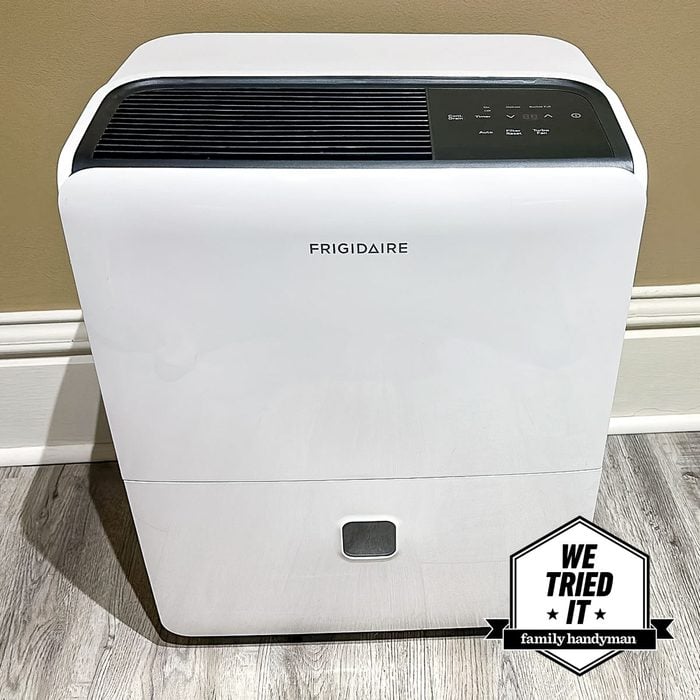 DEANE BIERMEIER FOR FAMILY HANDYMAN
DEANE BIERMEIER FOR FAMILY HANDYMAN
With an impressive 60-pint per day processing power and the ability to fully customize your humidity levels, this Frigidaire dehumidifier is perfectly suited for basement use. I tested this Frigidaire model and found that it exceeded my expectations despite its relatively lofty price tag.
Right out of the box, the unit looked and felt durable. Its cord wrap, louvers, wheels and filter cover are made of durable plastic, and I felt confident it could take some abuse and didn’t worry about causing damage when moving it from place to place. However, the unit is quite heavy. While I could, with effort, move it down the stairway to the basement using the two side handle indents, I recommend having a partner help with that task.
The Frigidaire comes fully assembled and ready to operate. If you choose to add a drain hose, installing one is a snap by simply removing the outlet cap, screwing a hose to it and stretching the hose to a floor drain.
I put this product to the test by cranking my desired humidity level to its lowest setting of 35%. The water reservoir is a generous 2.5 gallons, and I had to empty the bucket only once daily—a simple task of pouring the reservoir into a nearby sink basin. That’s less often than I expected, however, the outside weather had been relatively dry in recent weeks.
Overall, operating the unit was straightforward with easy-to-understand controls and a digital readout. On high speed, however, the fan noise was louder than expected but not annoying, and it was barely audible outside of the room I placed it in. Removing and cleaning the dust filter was a simple matter of removing it from the back and rinsing it off.
Pros
Cons
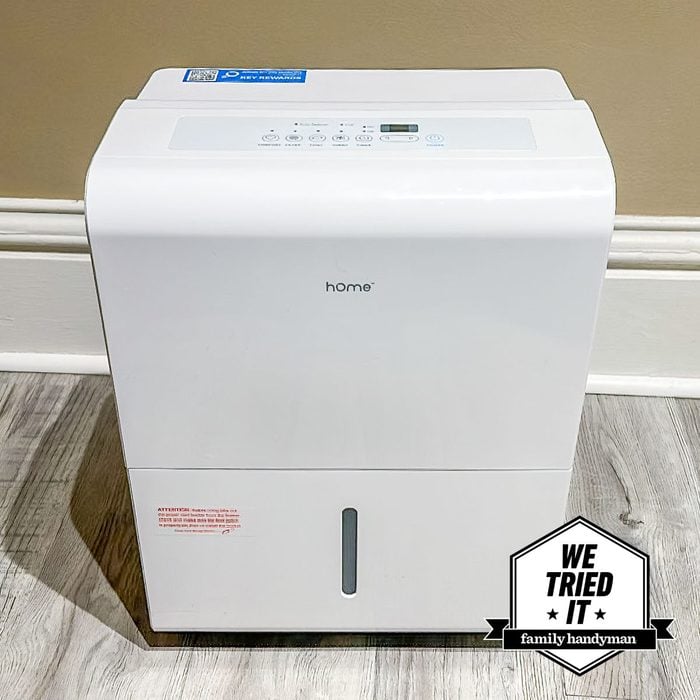 DEANE BIERMEIER FOR FAMILY HANDYMAN
DEANE BIERMEIER FOR FAMILY HANDYMAN
Despite the low cost of the HomeLabs Energy Star dehumidifier, it’s still capable of removing 22 pints of water from the air every day. I tested this unit and found it to my liking for numerous reasons, with just a few reservations.
I appreciate the dehumidifier’s low weight, which made it easy to transport up and down stairs or roll from room to room on its capable caster wheels. However, I think the focus on its lightweight also makes the unit feel somewhat fragile. While taking it out of the box and assembling it by snapping the cord wrap into place and removing the protective tape and pads, I noticed that the louvers and filter cover felt a little flimsy.
That flimsy feeling didn’t carry over to the water reservoir bucket. While small, at just under a one-gallon capacity, it felt rigid and solid. Emptying the reservoir was simply a matter of pulling it out of the front and pouring it into a sink. While the small bucket size made emptying it easy, it also meant more frequent attention is necessary. I had to empty the bucket after about 12 to 14 hours of operation, even during relatively dry outdoor conditions.
Overall, the HomeLabs 22-pint dehumidifier performed well, and operating it was simple with its easy-to-understand buttons and display. Its whisper-quiet operation was barely noticeable from just one room away.
The unit seems best for use in smaller basements. Mine is just over 800 square feet, and it worked well in that capacity. While the product says it’s good for up to 1,500 feet, I feel it might not have the power to handle such a large space adequately. Due to the limited bucket size, I also recommend adding a drain hose to the external port for convenience.
For an added customer service touch and to avoid making consumers search for information when they need help, I like that HomeLabs adheres a sticker with company contact information directly to the machine’s side.
Pros
Cons
P.S. Check out these best small dehumidifiers for smaller spaces.
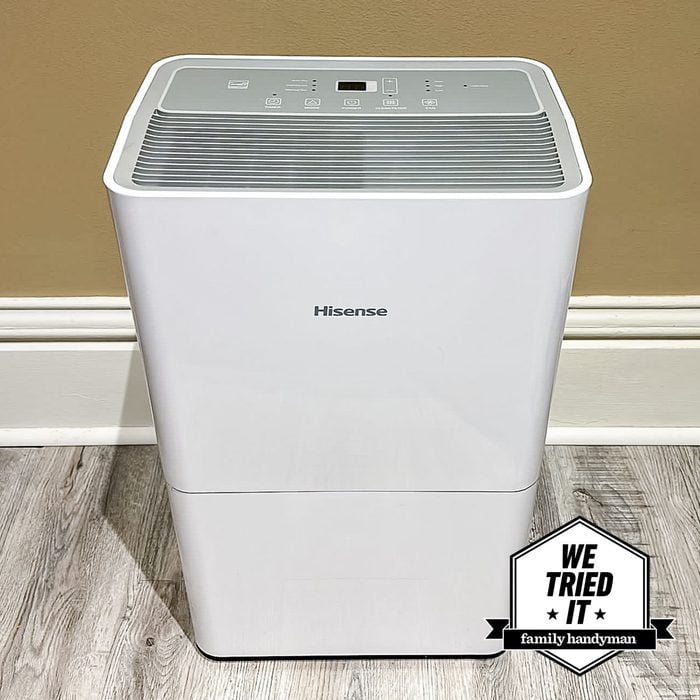 DEANE BIERMEIER FOR FAMILY HANDYMAN
DEANE BIERMEIER FOR FAMILY HANDYMAN
The Hisense Energy Star 50-pint dehumidifier stands out from the crowd of full-sized basement dehumidifiers not for its clean design, three operating modes, three fan speeds with an auto function and budget-friendly price—despite all being valid selling points. When I set up the Hisense dehumidifier after testing other similarly-sized models, the noise level was noticeably lower than the other full-sized units. Coming back down the basement stairs later to check the unit, I thought it had turned itself off until I was in the same room and could then hear it running.
While this dehumidifier indeed has the quietest operation of the ones we tested, keep in mind that it’s still a full-sized model and isn’t completely silent. The higher fan speed sounded much more like other, similarly sized models.
Overall, I was impressed with the Hisense’s simple operation and easy maneuverability, despite being slightly on the heavy side at 45 pounds. Two side handles help get the unit up and down stairs, and the relatively rugged wheels roll smoothly on the concrete floor. The unit comes with a side port for connecting a drain hose. However, a hose doesn’t come in the package, which is standard. Where I live, the weather was quite dry for several weeks before testing. Still, the Hisense could generate nearly one reservoir full of water daily on its lowest humidity setting of 30%.
The only apparent flaw in the model designed to dehumidify up to 4,500 square feet was the seemingly flimsy design of the water reservoir. I may not have needed to support it with two hands while emptying it, however, the sensation is that the design is a little weak, and using two hands seemed to be the better option. That said, the water reservoir design won’t be a factor if you opt to connect a hose for continuous draining.
Pros
Cons
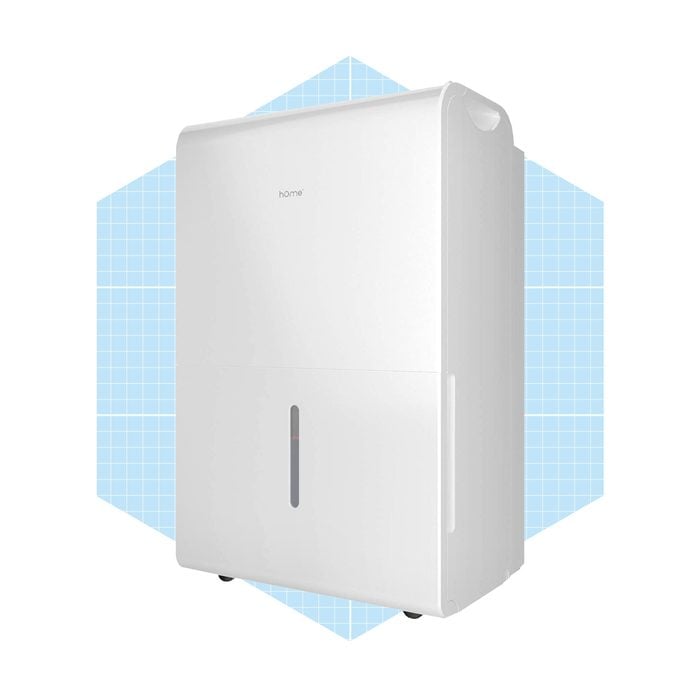 via merchant
via merchant
Capable of effectively removing 50 pints of water every 24 hours, the HomeLabs 4500 dehumidifier, along with its three drainage options, is our best dehumidifier for large basements. Covering up to 4,500 square feet, it also includes a drain hose and pump, so if you prefer not to use a removable reservoir or gravity drain, you can propel collected water directly into a sink or out a window.
This unit also automatically shuts off when the set humidity level is achieved or when the bucket reaches capacity. If power is interrupted, it even remembers the previous settings when power returns, so there’s no need to re-adjust them. If your goal is to prevent mold and mildew growth in your large basement with minimal effort, this unit is a prime choice.
Pros
Cons
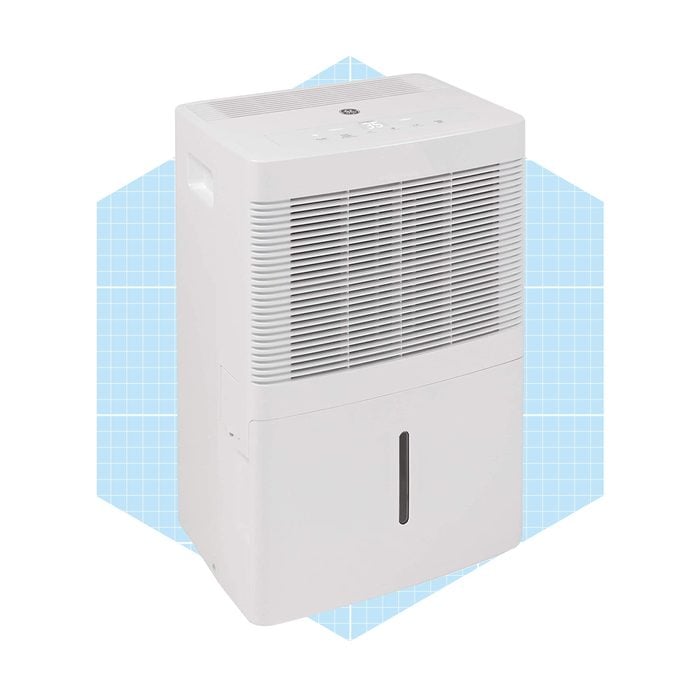 via merchant
via merchant
Whether your basement is on the smaller side or you’re focusing your moisture control on a specific basement bedroom, this lightweight and compact GE pick is the best dehumidifier for small spaces. At just 30 pounds, it’s convenient to carry or roll from room to room, and still effective enough to remove 20 pints of water from the air every day.
A helpful alarm also alerts you when the water bucket is full or missing, helping to prevent accidental leaks and spillage. Or you can attach a garden hose and empty it into a floor drain for continuous operation. Bright light-emitting diode (LED) lights illuminate the display interface, so it’s easy to read from across the room or in low-light conditions.
Pros
Cons
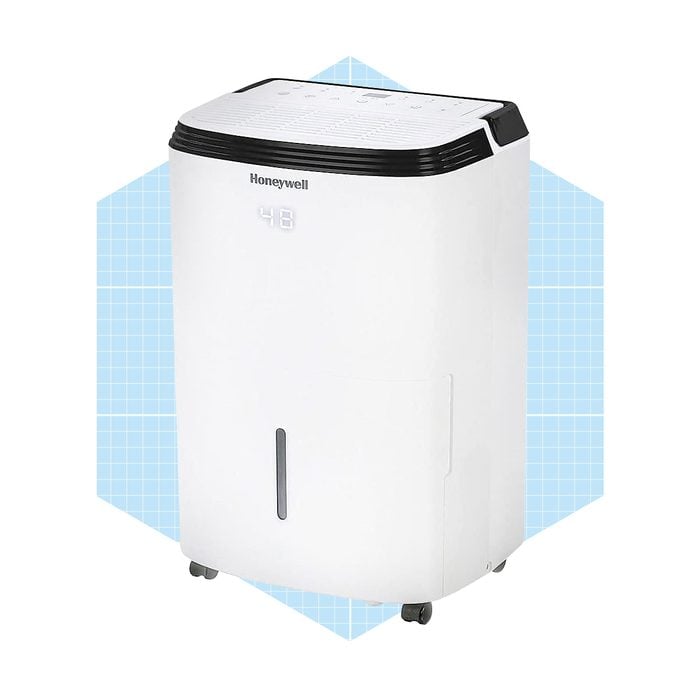 via merchant
via merchant
If you enjoy the convenience and hands-free operation of smart devices, consider the Honeywell Energy Star-certified dehumidifier. Its voice-controlled settings and fast speeds allow you to adjust its operation from across the room or—since it’s Wi-Fi-enabled—you can use your mobile device from practically anywhere. Capable of removing 50 pints of moisture daily, this dehumidifier is well suited for larger spaces and features a thermal overload protector for added safety.
Despite its high-tech capabilities, this unit features several practical design elements, like an anti-spill water tank and a heavy-duty carrying handle for added portability. With a rear-mounted cord winder and 360-degree rolling wheels, it easily rolls into a closet or storage room when you’re finished.
Pros
Cons
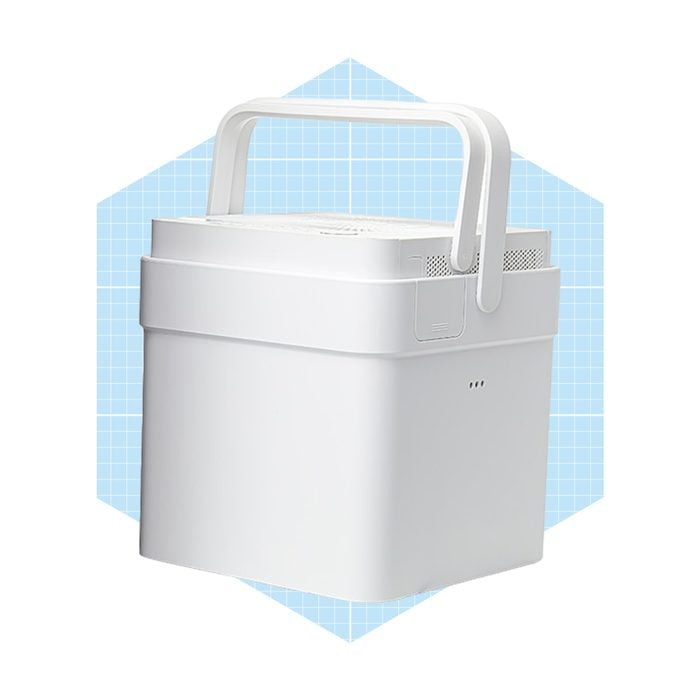 via merchant
via merchant
Thanks to its unique expandable design, the reservoir of the Midea Cube 50 holds up to 4 gallons of water before needing to be emptied, which means longer runtimes for it and fewer trips downstairs for you. The humidifier itself fits snugly inside the reservoir when not in use, and you simply lift it out and position it on top when it’s time to work. The nesting design makes it extremely efficient when storing and requires much less room than a similar-capacity humidifier. Plus, the square shape of the reservoir—combined with the large overhead handle—is much easier to carry and empty out than drawer-style versions that are more likely to splash and spill.
If you prefer to not empty it at all, the included drain hose allows for continuous draining. With Wi-Fi connectivity, this humidifier also works with Alexa and Google Assistant, providing you with real-time water and humidity levels, as well as full-tank alerts.
Pros
Cons
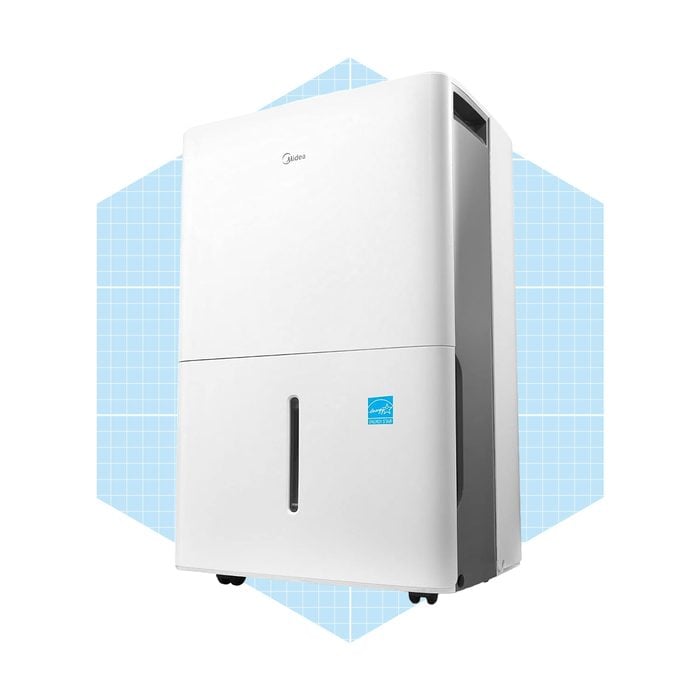 via merchant
via merchant
Classified as one of Energy Star’s most efficient models of 2023, this Midea dehumidifier is a smart choice for those with a larger space who still want to keep their energy costs low. The 50-pint capacity is strong enough to handle medium to large basements and offers tank and continuous drain options. With four wheels and two side handles, it’s easy to roll and reposition around your space, too.
Users with high-humidity issues will appreciate the turbo mode option for maximum power and fan speed, and the adjustable 24-hour timer increases overall efficiency even more.
Pros
Cons
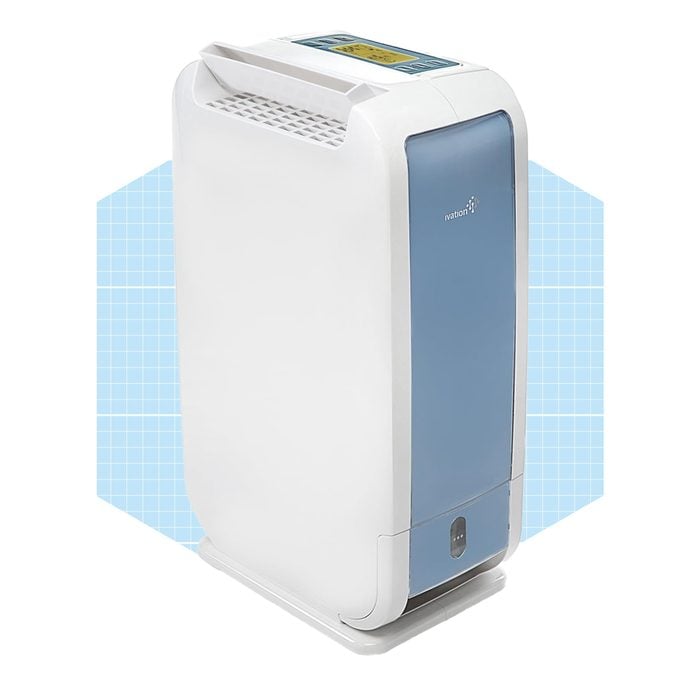 Via Merchant
Via Merchant
The Ivation 13-pint desiccant dehumidifier is a different kind of machine. While not suited for general basement dehumidification on the whole, the unit is more than capable of handling moisture issues in smaller basement rooms—particularly basement laundry rooms or bathrooms. The Ivation model doesn’t use a condenser to achieve results. Instead, a desiccant and fan motor do the work.
Although dehumidifiers that use refrigerant for dehumidification tend to be more powerful, the Ivation handles quite a load for its size and construction. Capable of reducing moisture levels in rooms of up to 270 square feet, the machine can remove up to 13 pints of water daily. You can bypass the small, half-gallon reservoir by using the included drain hose if desired.
This dehumidifier is lightweight at just under 14 pounds, so it’s easy to move from room to room when necessary. Its small dimensions of roughly 10 by 7 by 18 inches make it easy to fit in just about any room and store when not in use.
Pros
Cons
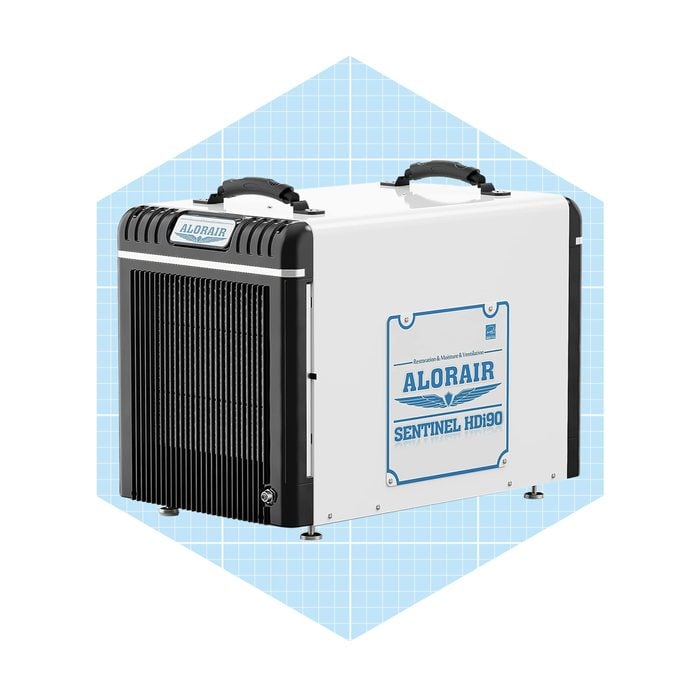 Via Merchant
Via Merchant
Readers might recognize the Alorair Sentinel HDi90 from our review of the best crawl space dehumidifiers. Unlike the other entries in our best basement dehumidifiers review, this powerful unit is best for permanent or semi-permanent and out-of-sight applications. While touted as a crawl space dehumidifier, the Sentinel HDi90 moves a whopping 210 cubic feet of air per minute and removes up to 198 pints of water per day, making it ideal for use in an unfinished basement.
The high-capacity model is even appropriate for whole-house dehumidification. Owners can easily tuck this unit away in the basement and all but forget about it. It can be vented to the outdoors by connecting duct work to the built-in adapter, and the machine comes with a condensate pump for easy placement above or below the nearest drain height. A wired remote control is also available for convenience above and beyond the unit’s settings memory that resets the machine after a power outage.
Pros
Cons
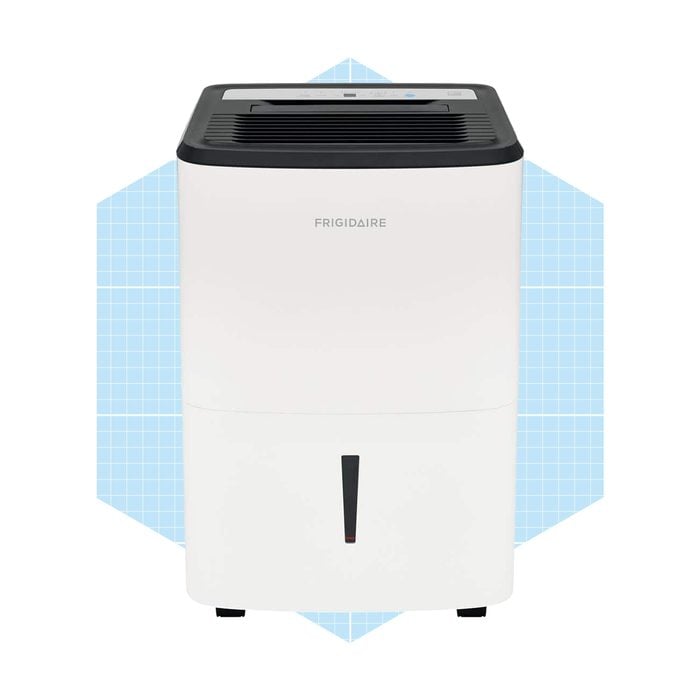 via merchant
via merchant
Featuring a built-in pump, the Frigidaire 50-pint dehumidifier doesn’t need to be manually emptied and expels accumulated water up and into a sink or out a nearby window. If you feel like utilizing the internal water tank instead, splash guards and a carrying handle reduce the chances of annoying spills during transport. This model is appropriate for cooler temperature basements and can function as low as 41 degrees Fahrenheit.
A washable filter captures airborne dust, increasing air quality as it lowers humidity. At 41 pounds, this additional pump feature does add some weight to the unit, but the collapsible handle and rolling wheels should make that less of an issue.
Pros
Cons
Dehumidifiers are challenging to tell apart, especially if you’re unfamiliar with how they work. When searching for the best dehumidifier for your basement, keep these factors in mind:
There are three basic types of dehumidifiers: refrigerant, desiccant and whole-house.
I have over 30 years of field experience in home construction, remodeling and repair. I’m currently a DIY home products and services expert for several publications. That kind of experience allows me the ability to test, critique and evaluate each product with a keen eye for the details most important to consumers.
As an experienced writer, I’ve used many years of practical experience to put this review together and determine the features that made the best dehumidifiers worth including. I also personally tested several of the models included in this list to give a real-world perspective.
When choosing the options for this list, I called upon my own experience using dehumidifiers in the past and consulted with an expert in the field, Tom Nolan, founder of All Star Home, who has 15 years of basement construction and waterproofing experience. I then gathered a pool of popular options, online reviews, familiar brands and recommendations from Energy Star. After narrowing that list by excluding models that failed to meet my criteria, like obscure manufacturers with little online or customer service presence, poor reputations for quality control and those without basic features, like a humidistat, I landed on the options listed here.
To provide the most accurate information possible, I analyzed and evaluated numerous industry-leading dehumidifier models. In my quest to describe my best findings for our readers, I also tested some of the top products to ensure accuracy in our choices. Only the best ones made the list.
My testing included examining and evaluating dehumidifiers right from the start when they arrived. I evaluated every detail from unboxing, assembly and setup to storage features and everything in between. Details were recorded about the feel and durability of each product, the general operation, testing of additional or unique features and performance attributes.
Notes were taken when things went well and, more importantly, where improvements might be necessary. After testing, I examined the notes and rated the products based on the results.
This depends on the size of your basement, as well as the initial humidity level. For example, a smaller, less humid basement dries much faster than a large, damp one. Luckily, the best basement dehumidifiers clearly state how many pints of water they collect from the air every 24 hours, so it’s easier to see which options work faster than others. Keep in mind that if you’re dealing with flood water, a dehumidifier alone isn’t going to cut it—you’ll need to use a shop vac as well.
To ensure your dehumidifier works efficiently, it should be placed as close to the source of moisture as possible. If your moisture isn’t coming from a specific area, place the dehumidifier in the center of the basement. Never place a dehumidifier against a wall, as it can obstruct its airflow and hinder its performance.
Yes! By removing the excess moisture that causes mold and mildew growth, a basement dehumidifier eliminates the musty smell caused by these uninvited guests. It may take a few days, but eventually, the basement dries out and the stinky odor goes away. (Basement odor eliminators are another smart way to get rid of that musty smell.)
This depends on the humidity level and size of the basement, but in general, yes, a 50-pint dehumidifier is well suited for basement use. A 50-pint dehumidifier is considered a large-capacity model, and according to the Association of Home Appliance Manufacturers (AHAM), is effective in up to 1200 square feet of space at 50% to 60% humidity levels. For spaces with extreme humidity levels of 80% to 100%, that shrinks down to about 800 square feet.
No, a basement dehumidifier should not run all the time. According to our experts, the humidity level in your basement should hover between 20% and 60%, depending on the season, so when that’s reached, your dehumidifier should shut off. Most dehumidifiers feature an automatic shutoff that can be adjusted to your preferred humidity level.
When dealing with basement moisture, the problem is more than cosmetic. You may also be dealing with potential mold or mildew problems—or at least their potential. For that reason, choosing the best basement dehumidifier for your home’s specific needs is crucial.
To that end, we’ve strived to provide the most accurate and up-to-date information to help you make a highly informed decision. Our evaluating and testing methods consider as many details as possible, including the least significant ones, to ensure we offer the best recommendations.
Source: